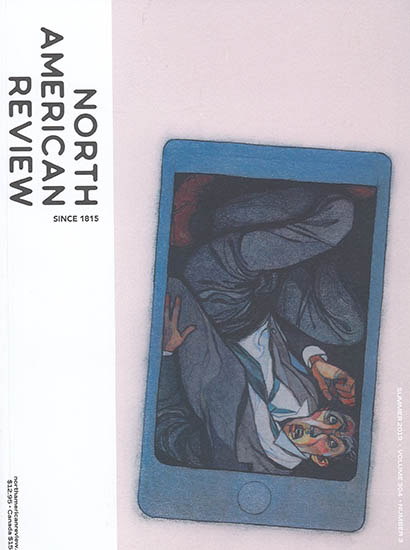304.3 Summer 2019

Buy this Issue
Never miss
a thing.
Subscribe
today.
We publish all
forms of creativity.
We like stories that start quickly
and have a strong narrative.
We appreciate when an essay
moves beyond the personal to
tell us something new about
the world.
Subscribe
From the Editors
With this issue the North American Review marks its golden anniversary at the University of Northern Iowa. Fifty years ago, in January 1969, UNI president James Maucker announced that the Board of Regents had given its permission for the university to purchase the magazine from Cornell College, where it had been published since 1964, having been revived by the poet Robert Dana after a nearly 25-year hiatus from its days in New York City. “The decision at Cornell College to discontinue operation of the magazine, largely for financial reasons,” explained President Maucker, “opens up the opportunity for us at UNI to try our hand….We have high hopes that it will provide a broad-gauge forum for diverse opinion on current public issues as well as a hospitable vehicle for first-rate literary works--that it will attract front-rank writers from throughout the world (including mirabile dictu, some from UNI)--and that it will symbolize the aspirations of the UNI community to foster full and free interplay of ideas on topics of basic significance.” We are publishing today as a consequence of his vision to “create a vital intellectual climate on the campus to nourish those who nourish the magazine.” We still aspire to the diversity, hospitality, and intellectual vitality President Maucker dreamed of back then and which Robley Wilson, the NAR’s first editor at UNI, worked toward for more than three decades.
Much has changed over the years, of course--and continues to change, as the new design and format of this issue should make obvious to anyone familiar with our previously glossy pages. Our more spacious dimensions allow the poetry and prose to breathe more easily, and even though we’re now going to be publishing tri-annually, following the regular fall- spring-summer academic rhythm that calls the tune in so much of the editors’ lives, each issue will consist of more pages, allowing the same amount of work to be included over the course of the year. We hope you also notice in this issue the striking visual art, which we’ll now be printing in full color.
These design updates are a result of our officially welcoming Sarah Pauls onto the masthead as the NAR Art Director. She has guided us through a more-than-year-long process of not only changing our visual identity but also reconsidering our mission. Since 2001 with the publication of our Multicultural Issue, one of our explicit goals has been to provide a venue for the widest range of literary voices possible. We remain committed as ever to this work and will take active measures to become worthy of a name proudly claiming to represent our vast and diverse continent.
Another notable change to the masthead represents an internal reorganization, namely abolishing the hierarchy among the editors. We may each specialize according to genre, but authority and responsibility for the NAR will be shared, and decisions about the magazine will be made through consensus.
What will stay the same? We’re still going to publish writing that we love. In this issue, for instance, we’re thrilled to showcase work by some of the featured writers at our April writing conference: poetry by Martín Espada and nonfiction by Taylor Brorby, Kij Johnson, Joyelle McSweeney, and Sophfronia Scott. We also hope you enjoy Zachary Vickers’ “Placebo,” winner of our recently revived Kurt Vonnegut Speculative Fiction Prize. (Next year’s prize will be judged by Andy Taylor, spread the word.) And in these pages you will find a newly unearthed, historical gem of a poem written fifty years ago on a plane by Allen Ginsberg, accompanied by a portrait by Gary Kelley.
Keep an eye on the NAR website, too, as it has also undergone some reconfiguration. Exclusive online work--including new poems, stories, essays, art, interviews, reviews, and blog posts--will now appear in a section we’re calling Open Space, an homage to contributing editor Terry Tempest Williams’s powerful book The Open Space of Democracy. We hope to post material here from the NAR’s archives on a regular basis, beginning with a series of poems by Philip Levine we published in the 70s and 80s, along with an essay by his former student Jeffrey Skinner, whose poem “Homage to Phil” appears in this issue.
On May 31, 2019 the world will celebrate Walt Whitman’s 200th birthday. The NAR will contribute its own yawp with Every Atom: Reflections on Whitman at 200, an online project curated by Brian Clements consisting of daily annotations of “Song of Myself” published in Open Space by writers, artists, historians, and scholars. Contributors include Harold Bloom, Rosanne Cash, Billy Collins, Michael Cunningham, Erica Jong, Maxine Hong Kingston, Camille Paglia, Marjorie Perloff, Nobel Peace Laureate Jody Williams, and many others. After 200 days, the annotations will be gathered and published on our site as a free interactive online version of the poem.
None of these changes or new projects, however, alter one important fact of the North American Review. As the oldest literary magazine in the United States, we carry with us the tangled legacy of American history. We have often celebrated the many important figures-- twelve US presidents!--whose writing has appeared in our pages, claiming that you can read the history of our nation by reading the NAR. But the tradition we are heir to requires that we face it more boldly, acknowledge the ugliness that is sometimes there, and engage in the serious, messy, difficult work of redemption.



